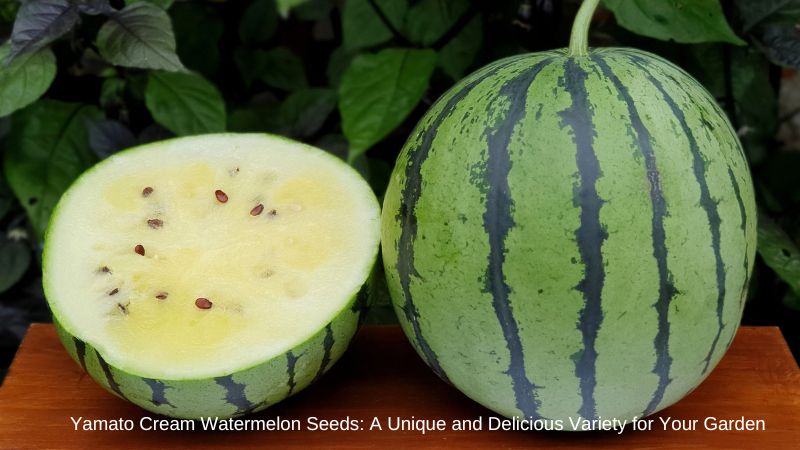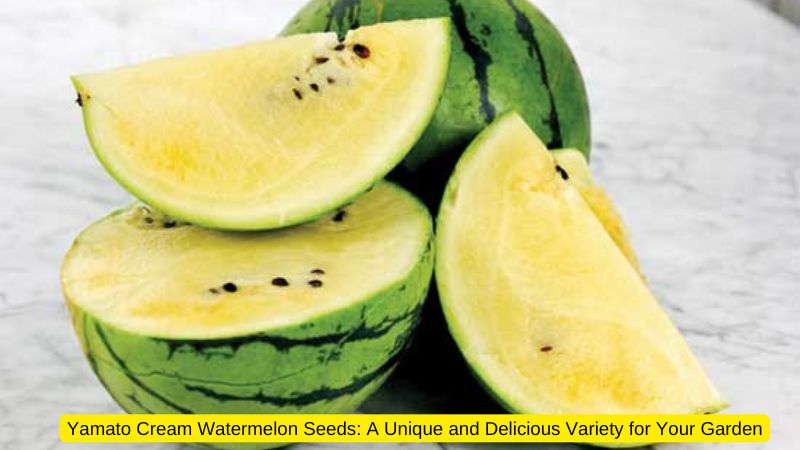Watermelon is a beloved summer fruit known for its sweet and refreshing taste. However, while most people are familiar with the traditional red-fleshed varieties, there is a unique watermelon variety that stands out: the Yamato Cream Watermelon. With its pale-yellow flesh, subtle sweetness, and creamy texture, this variety offers a delightful twist on the classic watermelon experience. In this article, Garden 03 will explore the history, growing tips, and benefits of planting Yamato Cream Watermelon seeds in your garden.
What Are Yamato Cream Watermelon Seeds?
Yamato Cream Watermelon is a lesser-known but increasingly popular variety of watermelon. Unlike the typical bright red or pink watermelons, Yamato Cream features a pale-yellow to cream-colored flesh. The fruit is slightly smaller than conventional watermelons, typically weighing between 5 to 10 pounds, making it perfect for small families or gardeners with limited space.
The flavor of Yamato Cream is uniquely delicate, offering a less sugary taste compared to red watermelons. The subtle sweetness is accompanied by a creamy, almost velvety texture that makes it a refreshing and light option for warm summer days.
Yamato Cream Watermelon seeds are the starting point for growing this exceptional fruit. These seeds can be planted in your garden, and with proper care and attention, they will produce beautiful, pale-fleshed watermelons that are sure to impress your friends and family.
The History of Yamato Cream Watermelon
The Yamato Cream Watermelon has its origins in Japan, where it was cultivated for its unique appearance and flavor. Japan is known for producing some of the world’s most interesting and innovative fruit varieties, and this cream-colored watermelon is no exception. The name “Yamato” refers to an ancient Japanese region, symbolizing a sense of tradition and high quality in agricultural products.
Over the years, this watermelon variety gained popularity for its distinct characteristics, especially its light flesh and mild flavor. As interest in unique heirloom and specialty crops has grown, Yamato Cream Watermelon has found its way into gardens and farmers’ markets around the world.
Today, Yamato Cream Watermelon seeds are available to home gardeners and commercial growers alike, offering the opportunity to cultivate a piece of this unique agricultural tradition in your own backyard.
Why Choose Yamato Cream Watermelon Seeds for Your Garden?

There are many reasons to consider growing Yamato Cream Watermelon seeds in your garden. Not only does this variety offer a unique flavor and appearance, but it also brings several other benefits that make it a great addition to any garden.
1. Unique Appearance
The pale-yellow flesh of the Yamato Cream Watermelon makes it a visually striking choice. Most people are familiar with the bright red or pink interiors of traditional watermelons, so cutting into a cream-colored watermelon is sure to surprise and delight guests at your summer gatherings. The contrast between the creamy flesh and the dark green rind creates a beautiful presentation for any meal or picnic.
2. Mild and Refreshing Flavor
While red watermelons are known for their intense sweetness, Yamato Cream Watermelon has a milder, more subtle flavor. The light sweetness pairs well with the creamy texture, making it a refreshing alternative for those who prefer less sugary fruit. It’s perfect for hot summer days when you want something hydrating and light.
3. Smaller Size
The smaller size of Yamato Cream Watermelons makes them ideal for gardeners with limited space or for those who want a watermelon that’s more manageable to store and consume. The average fruit weighs between 5 to 10 pounds, which is significantly smaller than traditional watermelons that can weigh 20 pounds or more.
4. Heirloom Variety
Yamato Cream is considered an heirloom variety, which means it has been passed down through generations of gardeners and farmers. Heirloom seeds are prized for their history, genetic diversity, and often superior taste compared to mass-produced hybrid varieties. By planting Yamato Cream Watermelon seeds, you are helping to preserve a unique piece of agricultural heritage.
5. Thrives in Warm Climates
Like most watermelons, the Yamato Cream Watermelon thrives in warm climates. If you live in a region with hot summers, this variety will perform well in your garden. It’s also a good choice for gardeners who use greenhouses or other temperature-controlled environments to extend their growing season.
How to Grow Yamato Cream Watermelon from Seeds
Growing Yamato Cream Watermelon from seeds is a rewarding process that allows you to enjoy fresh, unique watermelons straight from your garden. Watermelons require plenty of sun, space, and well-drained soil to thrive. Here’s a step-by-step guide to successfully growing Yamato Cream Watermelon seeds.
1. Choose the Right Location
Watermelons need full sun to grow properly, so choose a location in your garden that gets at least 8 hours of sunlight per day. They also require plenty of space to spread out, as the vines can grow quite long. If you’re short on space, consider using a trellis or other vertical growing methods to train the vines upward.
2. Prepare the Soil
Watermelons prefer well-drained soil that is rich in organic matter. Before planting your Yamato Cream Watermelon seeds, work compost or well-rotted manure into the soil to improve its fertility. The ideal soil pH for watermelons is between 6.0 and 6.8, so test your soil if necessary and adjust accordingly.
3. Planting the Seeds
Yamato Cream Watermelon seeds should be planted directly in the garden after the last frost date, once the soil has warmed to at least 70°F (21°C). Plant the seeds about 1 inch deep in mounds or hills spaced 4 to 6 feet apart. Each hill should contain 2-3 seeds, and once the seedlings have sprouted, thin them to the strongest plant.
If you live in a cooler climate, you can start your seeds indoors 4-6 weeks before the last frost. Transplant the seedlings to your garden once the soil has warmed and they have developed a few true leaves.
4. Watering
Watermelons need consistent moisture, especially during the flowering and fruiting stages. Keep the soil evenly moist but avoid waterlogging, as this can lead to root rot. A deep watering once a week is usually sufficient, but during hot or dry periods, you may need to water more frequently. It’s important to water at the base of the plant and avoid getting the leaves wet, as this can promote the spread of disease.
5. Fertilizing
To promote healthy growth, fertilize your watermelons regularly throughout the growing season. A balanced fertilizer with equal parts nitrogen, phosphorus, and potassium is ideal during the early stages of growth. Once the plants start flowering and producing fruit, switch to a fertilizer with a higher phosphorus and potassium content to support fruit development.
6. Pest and Disease Control
Like all garden plants, Yamato Cream Watermelons are susceptible to pests and diseases. Common pests include aphids, cucumber beetles, and squash bugs. Regularly inspect your plants for signs of pest damage and treat with insecticidal soap or neem oil as needed. To prevent diseases like powdery mildew or fusarium wilt, ensure good air circulation around your plants, water at the base, and avoid overhead watering.
7. Harvesting
Yamato Cream Watermelons are typically ready to harvest 70 to 90 days after planting. Knowing when to harvest is crucial for the best flavor. Here are some signs that your watermelon is ready to be picked:
- The tendril closest to the fruit turns brown and dries out.
- The spot where the watermelon rests on the ground turns from white to yellow.
- The skin becomes more resistant to scratching.
Once harvested, let the watermelon sit at room temperature for a day or two to allow the sweetness to develop further.
Culinary Uses for Yamato Cream Watermelons
The Yamato Cream Watermelon is not only unique in appearance but also versatile in the kitchen. Its mild flavor and creamy texture make it ideal for a variety of dishes. Here are some creative ways to enjoy your homegrown Yamato Cream Watermelon:
1. Fresh Fruit Salad
Combine diced Yamato Cream Watermelon with other summer fruits like strawberries, blueberries, and mint for a refreshing and colorful fruit salad. The pale yellow of the watermelon provides a beautiful contrast to the other vibrant fruits.
2. Grilled Watermelon
For a unique twist, try grilling slices of Yamato Cream Watermelon. The heat caramelizes the sugars, enhancing the sweetness and adding a smoky flavor that pairs well with savory dishes.
3. Watermelon Sorbet
Blend the flesh of the Yamato Cream Watermelon with a bit of lime juice and sugar to create a light and refreshing sorbet. This makes a perfect summer dessert that highlights the melon’s delicate flavor.
4. Watermelon Juice
Juice the watermelon for a hydrating and delicious drink. You can enjoy it on its own, mix it with lemonade, or even add a splash of sparkling water for a fizzy treat.
Conclusion
Planting Yamato Cream Watermelon seeds in your garden is a fantastic way to add variety and uniqueness to your harvest. This heirloom variety not only offers a visually stunning appearance with its pale-yellow flesh but also delivers a subtle, creamy flavor that sets it apart from traditional watermelons.





